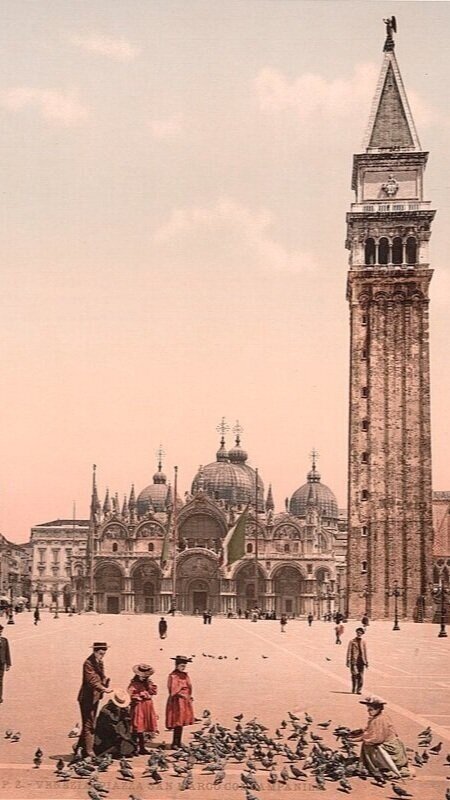“...and then we forget them all; for between those pillars there opens a great light, and, in the midst of it, as we advance slowly, the vast tower of St. Mark seems to lift itself visibly forth from the level field of checkered stones; and, on each side, the countless arches prolong themselves into ranged symmetry, as if the rugged and irregular houses that pressed together above us in the dark alley had been struck back into sudden obedience and lovely order, and all their rude casements and broken walls had been transformed into arches charged with goodly sculpture, and fluted shafts of delicate stone.”
St. Mark’s Square | Piazza San Marco, Canaletto, 1723.
Plan of St. Mark’s Square
The dashed lines in the center of the square represent the Church of San Geminiano and the stream (Rio di Batario) which flowed in front of it.
Upon his election in 1172, Doge Sebastiano Ziani turned the space in front of St. Mark’s Church into a great square, fulfilling his vision of Venice as a great city. He created the square by buying, at his own expense, the orchards that fronted St. Mark’s, owned by the nuns of the nearby Church of San Zaccaria. Ziani razed the Church of San Geminiano and rebuilt it 300 feet back, drained and filled in the stream in front of it, razed the buildings behind it, and cleared the orchards to create a trapezoidal space 600 feet long, 200 feet wide at the eastern end, and 270 feet wide on the west. He also filled in the canal along the western façade of the Doge’s Palace to create the Piazzetta, the leg of the Square extending to St. Mark’s Basin (“lagoon” in the plan above).
16th century view of St. Mark’s Square and the Piazzetta.
Galileo demonstrates a telescope on the Square, ca. 1610
View looking west by Canaletto (1739) showing the Church of San Geminiano before it was razed by Napoleon (ca. 1805) to build a throne room and ballroom, known as the “Ala Napoleonica” (the Napoleon Wing), now the Museo Correr.
Photograph of St. Mark’s Square showing the campanile (bell tower) before it collapsed in 1902 and was rebuilt “come era, dov’era,” where it was, as it was.
St. Mark’s Square from Jacopo di Barbari’s map (1500)
St. Mark’s Square at night by Francesco Guardi, 1755.
Sebastiano Ziani, the 39th Doge of Venice and architect of St. Mark’s Square.


